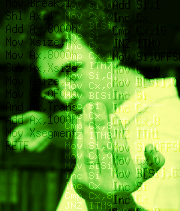Bon, il est temps que je blogge les cogitations de nouvelle année, vous ne croyez pas ? Je m'étais installé pépère dans le canapé pour récupérer un peu, agenda-cahier sur les genoux histoire de faire un peu le tri de ce qui doit encore être dit et ce qui doit être transférer dans la nouvelle année, mais c'était compté sans J.L.N.
Le p'tit bonhomme venait de se rendre compte qu'une SpongeBop, si on la repeind en vert, ça fait comme une branche d'arbre et que donc on pourrait en mettre dans la forêt! Il n'a pas tort, mais j'ai voulu vérifier ce qu'il connaissait déjà des autres habitants de la forêt de Bilou. Après tout, à part quelques parties de Apple Assault, il n'a pas encore eu beaucoup de contact avec la green zone.
Il y a Funky Funghi, notamment. Le champignon sauteur. Si je permets de ramasser les applemen à la manière des dumblador dans School Rush, que se passe-t-il quand on lance une pomme sur un Funghi ?
Sketches in this post were actually drawn on January 1st, while I was brainstorming Green Zone with my nearly-9-y.o. son. He's been mostly playing the School Zone so far, and only bits of Apple Assault. So little that he suggested I put a green spongebop as a spidey-branch platform of some sort.
At my first drawing of Funky Funghi, he'd almost immediately suggest that we can jump on his hat and use it as a platform to climb higher. Not a bad idea, but completely incompatible with the Commander Keen-inspired, decades-old setting where the whole funghi is highly toxic and that any contact should be avoided. But that was at a time where a Manic-Miner clone was considered.
L'idée de base, celle de la version BASIC, c'était que le champignon était ultra-toxique. Tiré assez directement de Commander Keen, je dois bien dire. Le moindre contact est dangereux pour Bilou. On ne peut même pas lui sauter dessus.
Mais bon, avec le recul, pour un premier niveau, c'est peut-être un peu exagéré. Je n'irais pas pour autant jusqu'à proposer que l'on puisse monter sur la tête de Funky Funghi et s'en servir comme plate-forme. Ce n'est pas franchement dans le caractère du personnage d'accepter ça.
Pas question non plus de permettre à Bilou de simplement 'pousser' Funky Funghi comme il le ferait avec un encrier (même si je n'ai toujours rien implémenté de la sorte ^^")
Faire se déplacer un ennemi sauteur invulnérable en visant correctement, voilà qui promet d'être fun. En tout cas, c'était fun dans Rayman.
I still would like to avoid a platform-like behaviour -- I even already have another mushroom design for that. And I now have throwable monsters in the rest of the game, meaning it would be good that we could pick up and throw applemen in Green Zone (that was the plan from long ago, before I came up with Apple Assault mechanics). That means something fun is bound to happen if you throw an apple at a funghi. Right ?
I bet being able to knock the otherwise-camping mushroom to an alternate location should be both fun and interesting (I take it from Rayman). But beware, said my bro: we don't want to end up locking the progression by poorly "chosing" where we put the funghi. And with an all-toxic one, chances that we lock ourselves are much higher. Especially with limited supplies of applemen in the level.
Mais contrairement à Rayman, on joue ici avec des "munitions" limitées. Il ne faudrait donc pas que l'on bloque un Funghi dans un coin du niveau où il peut nous empêcher définitivement d'avancer! Une solution pratique contre ça, évidemment, c'est de placer un 'trou à champignon' au bout de la zone-bac-à-sable dans laquelle il est prévu de le déplacer. Quoi qu'on fasse, il ne peut aller plus loin et on a remplacé "passer par-dessous l'obstacle" par "passer par-dessus l'obstacle", qui est en théorie plus accessible.
Final thought: if Edward is true claiming that goomba were picked mushroom-bumper-shaped because that should suggest the players they'll be safe jumping on them, making my bouncy-funghi hurt you when you stomp him won't be a neat way to teach the players they're in a traditional platformer when they're playing level 1 of Bilou's Dreamland. (not to mention that mushroom=bumper has been over-used in all platformers after that, to the point that it's almost more natural to try using them that way than trying to eat them and expect to grow or shrink, nowadays).
So let it be bouncy. But only his hat (foot is still toxic and you shouldn't try to push Funghi like you'd do with inkjet). And bumping you to the side as well. If you want to have a Funghi ride, you'll have to master it first. Else all you'll get will be a funghi-rodeo.
Mais tout ça devient secondaire si - une fois déplacé - Funky Funghi devient utile. Bon, comprenons-nous: ça reste un PNJ peu fiable et dangereux sous les bords. Disons par exemple que son pied reste toxique (on ne le pousse pas à la main) et redoutable (on ne reste pas trainer en-dessous). Mais son chapeau, lui, avec sa jolie tête de bumper pourrait ne réserver aucune vacherie et agir effectivement comme un bumper. Mais un qui soit susceptible de nous propulser vers l'arrière ou vers l'avant si on ne le prend pas bien comme il faut. Bref, un bumper qui amène une touche d'imprévu pour le joueur inexpérimenté, une touche de challenge pour le paddawan, et une variable supplémentaire à intégrer pour le Maître.
A méditer.
%20_%20Twitter.png)
%20_%20Twitter.png)







 Vote for your favourite post
Vote for your favourite post

